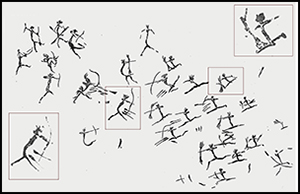Crossref Citations
This article has been cited by the following publications. This list is generated based on data provided by
Crossref.
Guilaine, Jean
2017.
Guerre et Technique.
p.
31.
López-Montalvo, Esther
Roldán, Clodoaldo
Badal, Ernestina
Murcia-Mascarós, Sonia
Villaverde, Valentín
and
Petraglia, Michael D.
2017.
Identification of plant cells in black pigments of prehistoric Spanish Levantine rock art by means of a multi-analytical approach. A new method for social identity materialization using chaîne opératoire.
PLOS ONE,
Vol. 12,
Issue. 2,
p.
e0172225.
López-Montalvo, Esther
2018.
Hunting scenes in Spanish Levantine rock art: An unequivocal chrono-cultural marker of Epipalaeolithic and Mesolithic Iberian societies?.
Quaternary International,
Vol. 472,
Issue. ,
p.
205.
Fernández‐Crespo, Teresa
Schulting, Rick J.
Ordoño, Javier
Duering, Andreas
Etxeberria, Francisco
Herrasti, Lourdes
Armendariz, Ángel
Vegas, José I.
and
Bronk Ramsey, Christopher
2018.
New radiocarbon dating and demographic insights into San Juan ante Portam Latinam, a possible Late Neolithic war grave in North‐Central Iberia.
American Journal of Physical Anthropology,
Vol. 166,
Issue. 3,
p.
760.
López-Montalvo, Esther
2018.
Prehistoric Warfare and Violence.
p.
87.
Rojo-Guerra, Manuel A.
García-Martínez de Lagrán, Íñigo
and
Royo-Guillén, José I.
2018.
The beginning of the Neolithic in the mid-Ebro valley and in Iberia’s Inland (Northern and Southern submeseta), Spain.
Quaternary International,
Vol. 470,
Issue. ,
p.
398.
Lillios, Katina T.
2019.
The Archaeology of the Iberian Peninsula.
Cintas-Peña, Marta
and
García Sanjuán, Leonardo
2019.
Gender Inequalities in Neolithic Iberia: A Multi-Proxy Approach.
European Journal of Archaeology,
Vol. 22,
Issue. 4,
p.
499.
Alt, Kurt W.
Tejedor Rodríguez, Cristina
Nicklisch, Nicole
Roth, David
Szécsényi Nagy, Anna
Knipper, Corina
Lindauer, Susanne
Held, Petra
de Lagrán, Íñigo García Martínez
Schulz, Georg
Schuerch, Thomas
Thieringer, Florian
Brantner, Philipp
Brandt, Guido
Israel, Nicole
Arcusa Magallón, Héctor
Meyer, Christian
Mende, Balazs G.
Enzmann, Frieder
Dresely, Veit
Ramsthaler, Frank
Guillén, José Ignacio Royo
Scheurer, Eva
López Montalvo, Esther
Garrido Pena, Rafael
Pichler, Sandra L.
and
Guerra, Manuel A. Rojo
2020.
A massacre of early Neolithic farmers in the high Pyrenees at Els Trocs, Spain.
Scientific Reports,
Vol. 10,
Issue. 1,
Bradley, Richard
2020.
A Comparative Study of Rock Art in Later Prehistoric Europe.
Herrero-Corral, Ana.M.
Garrido-Pena, Rafael
Flores Fernández, Raúl
Gutiérrez Sáez, Carmen
González-Martín, Armando
Held, Petra
and
Alt, Kurt.W.
2020.
A special body: Exposure ritual of a Bronze Age seated cadaver from the cemetery of Humanejos (Parla, Madrid, Spain).
Journal of Archaeological Science: Reports,
Vol. 33,
Issue. ,
p.
102517.
Yaroshevich, Alla
and
Khalaily, Khamoudi
2022.
Management of Symbols: Weapons Variability and the Emergence of Large Tanged Points in the Early Pre-Pottery Neolithic Context of Motza, Judean Hills, Israel.
SSRN Electronic Journal,
Yaroshevich, Alla
Eirikh-Rose, Anna
and
Khalaily, Hamoudi
2023.
Management of symbols: Weapons variability and the emergence of large tanged points in early pre-pottery neolithic context of Motza, Judean Hills, Israel.
Journal of Archaeological Science: Reports,
Vol. 47,
Issue. ,
p.
103790.
González-Rabanal, Borja
Marín-Arroyo, Ana B.
Vidal-Cordasco, Marco
Martín, Miguel Ángel
and
Ortega, Ana Isabel
2023.
Early Bronze Age violence in Ojo Guareña (Merindad de Sotoscueva, Burgos, Spain). Perimortem modifications in two male individuals.
Quaternary Science Advances,
Vol. 12,
Issue. ,
p.
100120.
Kačar, Sonja
Caro, Joséphine
Connolly, Rory
and
Defranould, Elsa
2024.
Encyclopedia of Archaeology (Second Edition).
p.
1009.



